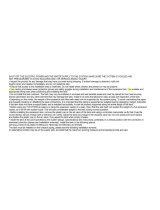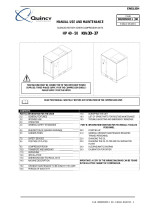
5
4 . 2 --- F i r s t s t a r t --- u p
(or after a long stop)
Operate as follows:
1) At least 8 hours before the start ---up, power the crank-
case heaters by setting the main isolator switch ON.
Make sure the auxiliary circuit has been powered and
check the operation (a fault due to an incorrect proce-
dure will invalidate the compressor guarantee).
2) Open the valves of the refrigeration circuit that had been
closed before the initial check.
3) Check the machinery suppl ying the thermal load connected
with the unit and start the system pump(s).
4) MAKE SURE THE COMPRESSOR OIL HAS BEEN HEATED
FOR AT LEAST 8 HOURS; start the unit only then.
5) Make sure the fans rotate in the correct direction (anticlock-
wise): check the electrical connections, if necessary.
6) Make sure the pumps rotate in the correct direction.
7) During the unit start ---up an inlet water temperature
higher than 20ûC is allowed. U nder standard operating
conditions check that the limits indicated in paragraph
2.1 are not exceeded.
8) Check the correct operation of the control and safety de-
vices.
9) Check the outlet temperature of the chilled water (check if
the set---point set on the controller is reached).
10) Check the oil level in both compressors.
11) With the compressors at full load, check there are no
bubbles visible in the frefrigerant sight glass. If there are any,
charge the unit according to par. 5.
4.3 --- Starting and stopping
ALWAYS ENSURE THAT THE COMPRESSOR OIL HAS BEEN
PREHEATED.
FOR BRIEF STOPPAGES MAINTAIN THE SUPPLY TO THE
CRANKCASE HEATER.
S Start the unit setting the Microprocessor swit ch ON.
S Stop the unit setting the Microprocessor switch OFF.
S In case of long stops, turn the machine off using the Micro-
processor switch OFF.
In this case the compressor crankcase heaters remain pow-
ered.
S For seasonal shutdown of the unit operate the main switch
located on the main electrical power supply. This will discon-
nect the compressor crankcase heaters.
4.4 --- Chillers serving special plants
The units are capable of cooling a water --- glycol mixture to tem-
peratures close to 0ûC without the need for significant modifica-
tions. In the case of modification, the set values of the safety and
cont rol components must also be changed. This can be carried
out in the factor y (at the time of testi ng) or at the time of installa-
tion, only by qualified and authorised personnel.
4 . 5 --- F r e e c o o l i n g
The “freecooling” is a system of pre--- cooling and/or cooling the
water/glycol mixture using ambient air when the latter is at a tem-
perature below the return mixture temperature. If the outside
temperature is sufficiently low to dissipate the entire heat load,
the refrigeration compressors automatically switch off, and the
mixture’s temperature is controlled by the fan speed adjust-
ment.
If the mixture temperature is too high for freecooling, the com-
pressors will operate as long as necessary to ensure the correct
water/glycol mixture temperature.
4.6 --- Microprocessor control
Consult the ”Microface and Hiromatic” Service Manual.
5 --- R e f r i g e r a n t a n d O i l C h a r g e
All work on pipes or components of the refrigerating circuit un-
der pressure must be exclusively carried out by qualified staff,
competent in such works.
5 . 1 --- R e f r i g e r a n t c h a r g e
WHILST REPAIRING THE REFRIGERATING CIRCUIT RE-
COVER ALL THE REFRIGERANT IN A CONTAINER: DO NOT
ALLOW IT TO ESCAPE. NEVER USE THE COMPRESSOR
FOR THE SYSTEM VACUUM (THIS INVALIDATES THE
WARRANTY).
S The unit is delivered charged according to the Tab. 5.
W arning for the refrigerant charge:
S Ensure there are no refrigerant leaks.
S Check the refrigerant type in the refrigeration circuit: a unit
originally charged by the manufacturer with R407C cannot
be charged with R22 and vice versa; possibly apply to the
Technical Support Department .
S Charge with the compressor in operation, connecting the
cylinder with the charge connector after the thermostatic ex-
pansion valve.
Flush the connection pipe between the cylinder and the
charging point; tighten the seal joint and then start charging
the unit. It is imperative that the cylinder is weighed both be-
fore and after the operation.
S For the units with R407C the refrigerant charge must be
made exclusively with liquid refrigerant.
S Charge the unit until the bubbles in the sight glass have dis-
appeared and the working conditions of the entire refrigera-
tion circuit have returned to normal (sub---cool ing and su-
perheating within the limits indicated below).
S Measure the superheating as follows:
1) Detect the temperature on the suction line, close to the
bulb of the thermostatic expansion valve, using a contact
thermometer.
2) Connect a pressure gauge (by max. a 30---cm pipe) with
the Schraeder connection and read the corresponding
saturated evaporating temperature.
3) The superheating is the difference between the two
readings.
4) For the units with R407C refer to the pressure gauge
scale indicated with the initials D.P. (Dew Point)
S V erify that the superheating is 5ûC --- 8 ûC.
S Measure the sub--- cooling as follows:
1) Detect the temperature on the liquid line using a contact
thermometer.
2) Connect a pressure gauge (by max. a 30---cm pipe) with
the Schraeder connection on the liquid line and read the
corresponding saturated condensing temperature.
3) The s ub---cooling is the difference between the two read-
ings.
4) For the units with R407C refer to the pressure gauge
scale indicated with the initials B.P. (Bubble Point)
S V erify that at the condenser outlet, sub ---cooling is 3ûC---
5ûC.
IT IS IMPORTANT TO CARRY OUT CHARGING CORRECTLY.
An excess of refrigerant cause s an increase in sub--- cool ing and
consequent operating difficulties in the hot season; a shortage
of charge generates an increase in superheating and poss ible
compressor stoppages. Whenever work is carried out on the
unit, ensure afterwards that the working conditions are correct,
checking sub---cooling and superheating.
5 . 2 --- O i l c h a r g e
Contact the Technic al Support Department for the specifications
of the oil to be used for topping up; the oil changes according to
thetypeofusedrefrigerant.
NEVER MIX DIFFERENT OILS TOGETHER. CLEAN THE PIP-
ING COMPLETELY BEFORE CHANGING THE TYPE OF OIL
USED.






















